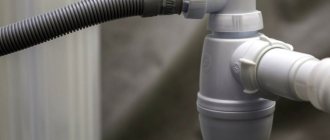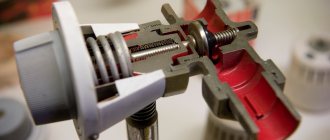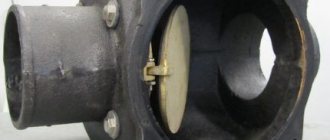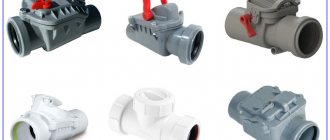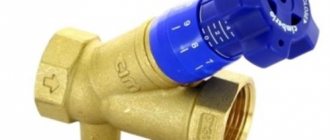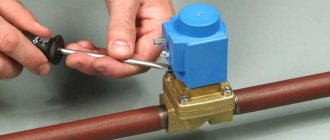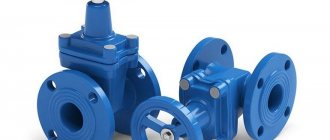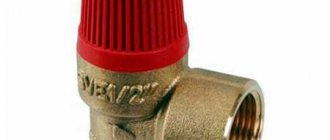Menu:
- Fan valve for sewerage 110 and 50 mm
- Installation of vent valves
- Reviews
- Check valve for drain pipe 110 and 50 mm
- Vacuum fittings
- Watch the video
To stabilize the pressure inside the line, a vacuum valve is needed. Sometimes it is called fun. Installation of this part helps prevent flooding of the building with sewage.
The device also protects buildings from unpleasant odors. You can also use fan channels for this. However, their installation is quite complicated. The channel needs to be led to the roof. This operation helps to depressurize it. Fan channels are prohibited from being placed near windows. Therefore, the use of a vacuum valve is more convenient.
In this article you will learn a lot of useful information, and you can also see photos of the equipment in question.
Pros and cons of using a vent valve
To prevent gases, vapors and odors from the pipeline system from entering the house, ventilation is provided, which will facilitate their removal from the system.
The principle of ventilation is based on the flow of air from the ventilation pipe of the septic tank, the passage of air flows through external and internal sewer networks and their exit through the ventilation duct leading to the roof. Thus, the air passing through the septic tank and sewerage system carries with it all the odors, exits along with them through the ventilation riser in the roof and then dissipates. If there is no ventilation system, unpleasant odors and volatile substances from the septic tank and pipes can enter the room through broken hydraulic valves.
The presence of a ventilation system in the building ensures that odors do not penetrate into the premises even if the siphons break or dry out. But sometimes setting up a fan channel is impossible or causes great difficulties.
This may occur due to the characteristics of the roofing material, due to the roof being used, or the impossibility of locating the outlet of the exhaust riser away from balconies, windows, and ventilation systems. In this case, the exhaust part is taken out into the attic, and an aerator is mounted on its top.
A vacuum valve cannot be a complete replacement for ventilation risers, but its use can be justified by the following advantages:
- easy and quick installation;
- saving money;
- impossibility of installing a fan riser;
- minimizing heat loss through ventilation risers;
- improved operation of the sewer network and greater freedom in its planning.
Simply put, the ventilation valve solves only one problem - it prevents the vent valve from breaking, while the vent riser equalizes the pressure in the network, and also ventilates the septic tank and the internal sewage system.
When installing a non-ventilated system or replacing the ventilation riser with an aerator, it is necessary to correctly calculate the throughput of the network in order to eliminate the possible breakdown of siphons or failure of fan valves.
It should also be taken into account that if the building is not inhabited all year round, it may happen that the hydraulic valves will not be filled with water (dry out) and air from the sewer will flow into the premises, which will not happen when installing a ventilated riser.
Operating principle of the device
Similar to the design features, all types of vacuum valves are distinguished by the same operating principle:
- the device is closed in the standard state, the internal pressure of the sewer is equal to or slightly higher than atmospheric pressure;
- an open device allows masses of air to pass through, which allows displacement of the membrane in cases of rarefaction (for example, large volumes of water waste are drained, etc.);
- the valve closes again.
The main purpose of the ventilation valve and drain pipe
The ventilation valve is used to allow air from the room to pass into the sewer pipe. Thus, sometimes the vacuum that occurs there is compensated by an activated valve, which allows air into the internal cavity of the sewer. The presence of a ventilation valve is an effective guarantee against the breakdown of siphons and, consequently, against the penetration of unpleasant odors from sewer lines into the house. The scope of application of the ventilation valve is limited to this only.
In this regard, an alternative to the valve is a drain pipe, that is, a riser leading from the sewer to the roof. Such a pipe does not require additional maintenance and does not break. Moreover, this pipe can additionally provide ventilation for the home sewerage system and the cleaning systems available at the house.
So, from the above it is clearly clear that ventilation of the sewer network of the house is ensured only by the drain pipe.
When an adaptation is needed
The first signal about the need for an air valve is the appearance of extraneous noise in the system or the spread of unpleasant odors. Any deviations from normal functioning are immediate clues that there are problems with the sewer system. Installation of a vacuum valve is necessary to compensate for pressure.
With the help of the device, not only the problem of replacing the ventilation riser is solved, it helps in the following cases:
- impossibility of installing a drain pipe (riser);
- the need to reduce heat loss through ventilation;
- improving functionality and direct sewerage operation;
- protection against failure of fan elements.
Types of valves and principle of operation
There are several types of sewer check valves of 110 and 50 millimeters, which differ in their scope of application. Accordingly, all types of mechanisms have a different design and operating principle of one element.
When the waste liquid approaches, the damper automatically rises, after which it returns to its original position. It is by the mechanism of operation of the damper that models of sewer check valves are classified.
Rotary
This type of sewer valve has a spring-loaded membrane (it is called a plate because of its round shape). When the wastewater moves in the right direction, the plate rotates and moves upward without impeding the movement of liquids.
However, when the drains are directed in the opposite direction, the spring-loaded membrane is pressed tightly against the outer rim, as a result of which the working area of the pipeline is blocked.
Some models additionally have a built-in additional damper, which is controlled manually. This locking mechanism can be adjusted using a special button located on the body of the device.
Thus, the pipeline first has an expanding and then a narrowing section, which is a possible place for the formation of a blockage in the sewer system. The solution to this problem is to place the lid mechanism at the top of the housing. By removing it, you can easily and quickly remove the clog that appears.
Lift valve for sewerage
The name of this type of device is based on the mechanism of the damper.
When wastewater moves in the correct direction, the flapper is positioned at the top. Operating principle: the liquid exerts pressure on the membrane, which blocks the movement of waste, the internal spring is compressed, as a result of which the damper rises. If the wastewater does not move, then the spring is in its normal state, and the path of the wastewater is blocked.
Due to the nonlinear body shape, when the fluid moves in the opposite direction, opening the valve is impossible, which ensures complete safety from flooding.
This type of check valve for sewage 110 or 50 mm has greater operational reliability than the rotary (petal) model, but there is also a drawback.
The shape features make it necessary to regularly clean the system, because... it gets clogged periodically. To perform this procedure, you will need to unscrew the bolts (4 pcs.), then thoroughly clean or, if such a need arises, replace the working mechanism. If the owner has the opportunity to carry out regular cleaning, then it is better to purchase a similar version of the check valve.
Ball valve
In this type of device, the locking element is a small ball. The upper part of the body is designed in such a way that when wastewater flows, the ball falls into a separate hole and allows the flow to move.
When there is no fluid present, the working area of the pipe is blocked, preventing flow from flowing in the wrong direction. However, such models have a drawback - unlike the rotating and lifting mechanism, in this design the ball valve does not completely adhere to the rim of the device.
As a result of a leak, a small amount of waste water may leak. Of course, the likelihood of severe flooding, as if the sewer check valve were missing entirely, is minimal.
Wafer
The main advantage of this type of locking mechanism is its small dimensions, which makes installation possible even if there is no free space behind the plumbing fixtures. Externally, the device looks like a miniature cylinder with a special rotary valve.
This element can consist of 2 components that are fixed to the central rod, or in appearance it can resemble a small plate that is fixed to the body using a spring mechanism.
It is advisable to install this option only if other varieties cannot be installed. Even taking into account the small size, it is still advisable to give preference to other types of devices. A 50 mm wafer check valve for sewerage is installed quite rarely, because... belongs to the category of water supply equipment. For sewer systems, its efficiency is quite low.
Another disadvantage of this design is the inability to quickly clean the device. Due to its shape, the connection will need to be completely disassembled to clean the valve.
What is the importance of drainage system ventilation?
Sometimes the question arises: is the organization of ventilation in the drainage pipeline really so important? There are at least two reasons for this.
- During the decomposition of organic substances, gas fumes that are extremely dangerous to human health are released. Poisoning from sewer fumes, including fatal cases, is not uncommon.
A specialized valve for ventilation built into the sewerage system eliminates the possibility of concentration of dangerous gases, promptly releasing them outside.
- Another pitfall. In the absence of ventilation circulation inside the pipeline, foul-smelling and dangerous gases gradually accumulate, eventually breaking into the home. It is difficult to get rid of a repulsive, disgusting aroma in rooms, so you should take care in advance to ensure that the fan boner eliminates large-scale troubles.
Does installing a vacuum valve solve all problems?
Alas, no, of course not.
Let's return again to the fan pipe, made according to all the rules. It not only performs the function of equalizing pressure inside the system, but also provides effective ventilation. Its installation is highly recommended in the following cases?
- If the house has more than two levels (floors) with installed plumbing and sewerage running through all these levels.
- If for some reason you had to install a riser from a 50 mm pipe.
- If the house has a large tank, something like a sauna pool, which has to be emptied periodically.
- If the septic tank is located close to the house, and an unpleasant odor emanates from it into the living area.
That is, in such situations, the need for a vent pipe, in theory, should not even be discussed.
Sometimes homeowners are tempted to not bother with running pipes through the roof. That is, limit yourself to installing a vacuum valve at the top point. I must say right away - this is not the best option.
The aerator should be considered as a necessary measure when removing the drain pipe is impossible in principle. Or - to simplify and reduce the cost of a general scheme with several risers. There is no need to bring them all out through the roof to the street - one drain pipe will be enough, and on the remaining risers, high-quality valves at the highest point in the premises are quite sufficient. That is, ventilation will be provided - and the issue will also be resolved with vacuum.
Here is one acceptable solution to the problem: several risers, of which one goes into a waste pipe, and the rest are equipped with vacuum valves at their highest point.
Is sewer pipe ventilation really that important?
- Firstly, when organic matter decomposes, gases that are extremely dangerous to human health are released. And poisoning with such products, including fatal ones, is not at all such a rarity. It is better that they do not concentrate, but release into the atmosphere in a timely manner.
- Secondly, there is another pitfall. If there is no ventilation air circulation in the pipes, then the accumulation of fetid gases has nowhere to go, and sooner or later it will leak into the premises. A simple example: a family, having been out of town for the weekend, went to “winter quarters” for a week. During this time, water simply dried up (evaporated) from some very small siphon (say, a drain in a shower room or a siphon under a bathtub). And the beloved dacha greets its owners with a wild stench in the rooms, as gases accumulated in high concentrations from the sewer rush out.
And with a drain pipe, such large-scale troubles can be avoided.
* * * * * * *
Conclusion: a vacuum valve is a very useful element of the sewerage system, which in some cases allows you to significantly simplify the circuit and avoid breakdowns of water valves on long horizontal and other problem areas. But considering it as a full-fledged replacement for a waste pipe is unacceptable!
The reason is that it does not provide the necessary ventilation of the sewer line. Without this, talking about the usefulness of the system being created will still be an exaggeration.
Installation
For the most part, plastic sewers are installed in private houses and apartments. Air valves are also selected from the same material - PVC or polypropylene. Like any sewerage products, they have a socket with a rubber seal at the end. The whole installation consists of putting the device on the prepared pipe. All.
For reliability, you can first coat the joint with plumbing sealant, but even without this measure the connection is airtight (as long as the pipe and device are of normal quality).
Design and principle of operation of the fan valve
Now let's look at how the air ventilation valve for sewage works and how it works.
The fan valve has the following device:
- A housing with a hole on the side (through which air enters). Made from polymer material (polypropylene or PVC).
- Removable cover. Necessary for disassembling the aeration valve (for cleaning or repair).
- Rod or membrane. Made from rubber.
- Rubber sealing gasket. Limits the stroke of the rod, seals the structure.
The vacuum ventilation valve for the riser works as follows:
- when the pressure inside the pipe is the same as atmospheric (or slightly exceeds it) - the valve is closed;
- when water (from a toilet, washing machine, tap) enters the drain, a vacuum occurs inside the pipe, displaces the rod (membrane), and opens the valve;
- the air entering through the valve equalizes the pressure, after which the rod (diaphragm) returns to the seat (the valve closes).
Pros and cons of use
The advantages of using a sewer aerator:
- the ability to prevent the appearance of an unpleasant odor inside the room (if the normal operation of the riser ventilation is disrupted);
- the ability to do without laying a vent pipe (which means not making an extra hole in the roof).
It should be noted that it is possible to use a valve on an unventilated riser, but this will only be effective in low-rise buildings. For multi-storey buildings, ventilation valves are considered an additional component to the pipe leading to the roof.
In principle, they can also be used separately, but only as a last resort. And in this case, an accurate calculation of both the number of devices and their throughput will be required (which should be done at the design stage of the building itself).
Design and principle of operation of the sewerage air valve
One of the obvious disadvantages of the sewer aerator is the possibility of it jamming. The movement of the rod (membrane) can worsen both from time (natural wear of parts) and from the ingress of some debris. The second option is unlikely, since foreign objects can only get inside when opening the lid.
About technical characteristics (diameter) and manufacturers
The main technical characteristics of the sewer aerator are:
- Diameter. Based on this parameter, a model is selected for the pipe diameter.
- Throughput (how much air will pass per unit of time).
The diameter of the product can be 50, 75 or 110 mm. Models with a diameter of 50 and 75 mm are suitable for installation for individual devices. Products with a diameter of 110 mm are intended for installation on the riser itself.
Ventilation valve on the riser
Some valves are designed in such a way that they are suitable for several diameters at once (they have a stepped pipe). For example, the HL900N model can be used for pipes with a diameter of 50, 75 or 110 mm. For installation on pipes of other diameters (32, 40 mm), adapters can be used.
As for throughput: it was already mentioned above that 1 l/s of water can consume 25 l/s of air. Valve performance is from 7-8 l/s (for HL903 and Minivent) and up to 32-37 l/s (for HL900N).
The Russian market offers products from about a dozen manufacturers. Here are a few specific brands:
- HL (Austrian company, its products are the most expensive).
- McAlpine (McAlpine, English company, mid-price segment).
- Wavin (Polish manufacturer, mid-price and expensive segment).
- Europlast (Ukrainian brand, cheap segment).
Where is the fan aerator installed?
The ventilation valve can be installed in two ways (according to location):
- For the boner. In this case, it is located on its upper part, which can either be led out into the attic or located directly in the room (bathroom).
- For a separate appliance (for example, a washing machine).
Classification of aerobic valves
There are several types of sewer air valves, most often they are divided according to their dimensional characteristics. This is very important, because depending on where the valve is installed, you should select the appropriate size.
Two types are most often used:
- for centralized sewer drainage – sewer aerator 110 mm in diameter;
Sewer aerator 110 mm
- for connection with various plumbing fixtures - 50 mm in diameter.
sewer aerator 50 mm
Types of aerators
There are mechanical, electric and petrol tools. How to choose an aerator? Most gardeners are guided by the surface area of their lawn. If hand tools are suitable for small areas, then it is more advisable to aerate a large lawn using electric or gasoline machines.
Aerators for small areas (manual, foot, mechanical)
- metal forks
- studded sandals
- rake
- mechanical roller with spikes
Pitchfork. Using an ordinary garden fork, you can aerate a small lawn. The lawn should be pierced approximately half the depth of the tool. A puncture of 7–13 cm will be most optimal. It is not recommended to make frequent holes; 10–15 cm between rows will be enough.
Sandals with spikes are suitable for aerating a small lawn. The plastic or metal sole is secured to the shoe using several straps. The sole of the foot lawn aerator is equipped with 15 - 20 spikes, 3-5 cm in length. It is necessary to carefully secure the sandals to your shoes and walk in them on the grass. Steps should not be taken infrequently, approximately 20–30 cm each. To make walking easier, it is recommended to raise the sole of the foot parallel to the ground. A good exercise to improve your health!
A rake can also be used for aeration. It is inconvenient to make punctures with them, but by scraping along the surface of the earth, it loosens, which helps to aerate the soil. They are made from high-strength steels and equipped with thin, long teeth. A rake allows you to remove dry leaves, grass clippings and weed roots. Use the rake only on short-cut grass!
A mechanical aerator is a heavy iron roller with sharp spikes attached to its surface. Under the influence of the weight of the roller, the spikes penetrate the soil, loosening it. The disadvantage of a mechanical lawn aerator is that its use requires physical strength and considerable dexterity.
Aerators for treating large areas (electric and petrol)
These tools are quite expensive, so you should choose them responsibly
When choosing a tool, you should pay attention to the following features:
- Engine power. If the lawn area is large, then choose an aerator with high engine power. Such machines have an increased engine life, which allows the engine to operate longer than usual.
- Width of working surface. The wider the working surface of the aerator, the larger the area it can process in one pass.
- Machine body. Plastic is lightweight, but metal is much more durable.
- Container for collecting grass. It will be needed if the lawn area is large.
- Types of knives. Aerators have long metal spokes that pierce the soil cover. Scarifiers have special knives that remove withered grass and weeds.
For large areas of lawn, it is recommended to use electric or gasoline lawn aerators. Some models are multifunctional and equipped with additional sets of attachments, so scarification and aeration are available to them. Such universal machines perform several functions:
- make punctures (aeration) or cuts (scarification) in the soil
- remove caked grass residues
- collect the removed grass stems into a special container
- loosen the soil using an additional attachment.
An electric aerator is convenient if the length of the cord allows you to treat the entire lawn area.
Electric aerator/scarifier
The gasoline device can be effectively used over a large area because it operates autonomously.
Gasoline aerator
Selecting a valve for the sewerage system
Finding the right device for use in a specific area and in a specific off-grid sewer system can be difficult. During the process, it is important to pay attention to the specifics of the fasteners, the principle of operation, the level of internal pressure, and the direction of installation of structures.
The following features and characteristics are taken into account:
- high quality parts and elements that must be resistant to aggressive chemicals;
- availability of manual control of structures;
- the presence of protective mechanisms against rodent pests that can penetrate the sewer system.
If you install an air valve in your home sewer line, this simple step will relieve the occupants of the premises from the stench emanating from the pipeline. This useful device will eliminate the problem of unpleasant odors, and will also allow you to save some money on periodic repair work.
How does a vacuum valve work?
It is already clear from the purpose of this device that it must remain closed when there is excess pressure in the sewer pipe or when it is equal to atmospheric pressure. But if a vacuum occurs in the pipe, the valve mechanism must ensure the opening of the passage for air to enter from the outside.
The principle is easily implemented with the “involvement” of ordinary gravitational forces. The diagram below shows the structure of one of the aerator models. Despite possible differences in the design of valves from different manufacturers, the principle remains virtually unchanged.
An example of a device and a demonstration of the principle of operation of a vacuum valve for sewage.
The entire valve mechanism is assembled in a polymer housing (item 1). The device itself implies only a horizontal arrangement, so in its lower part one or another device must be provided for a sealed connection with the sewer pipe. In the example shown, this is an elastic cuff (item 2) for inserting the aerator into a socket or even just into a cut pipe. There may be a connecting unit in the form of a standard sewer pipe socket or other options. But this installation is always simple, reliable and understandable.
Air can enter the aerator through the intake grille or slot-like openings (item 3). They are located at the bottom or on the side of the valve "head", but outside air will almost always be applied to the valve diaphragm from below.
This is very easy to explain. The valve flap (pos. 5) is located in the seat assigned to it (pos. 4) and fits tightly to its edges with an elastic cuff (membrane), preventing air from passing from the pipe into the room. And the fit is ensured by the banal force of gravity of this damper. That is, even if the atmospheric and established pressures in the pipe (riser) are equal, the valve will be closed. This can also be facilitated by some excess pressure in the pipe, since gas formation in the sewer almost never stops. That is, the valve will thereby be pressed even more against the seat (in the diagram it is the left fragment).
But if, for one reason or another, even a slight vacuum is created in the pipe, atmospheric pressure will overcome gravity and lift the valve above the seat. As they say, “nature abhors a vacuum,” and the outside air will rush into the pipe, equalizing the pressure and preventing the siphons from breaking.
To prevent the damper from warping, it may have special guides (item 6). However, many models can do without them - centering is done due to the cylindrical shape of the valve assembly.
Aerator for 110 mm pipe - model with two valve heads. One of them has been disassembled to demonstrate its simple device.
Out of pure curiosity, you can “disassemble” several more vacuum valves of various models. But we still won’t find any fundamental differences there.
The differences in the design of different valve models are not fundamental.
By the way, since the device is being considered, you can immediately draw the readers’ attention to the “Achilles heel” of any valve. This, of course, is the membrane itself, more precisely, that area of it that is pressed by gravity to the valve seat
And here we are not talking about wear (if it exists, it is very unnoticeable), but about other obstacles that can prevent the sash from sealing:
- Over time, dust can accumulate on the valve seat or on the membrane itself, which can turn into hard lumps of dirt that prevent the valve from sealing tightly. Often the owners are notified of this by the “aroma” of sewerage entering the premises. The first thing to do when such a “bell” comes up is to check the cleanliness of the membrane and its fit, and carefully clean the assembly from contaminants.
- The second conclusion is that the vacuum valve must be installed only in a heated room of the house. Otherwise, with the onset of cold weather, drops of condensate may freeze on the seat or on the membrane, and the valve mechanism will not fit properly. And in general, too large temperature changes do not benefit the rubber membrane - it begins to “tan” in the cold, losing the necessary elasticity.
Otherwise, the mechanism is extremely simple, and it is difficult to come up with any circumstances that would lead to a breakdown of the vacuum valve.
The best manufacturers and popular models of aerators
Before installing any type of sewer system component, you should consider the following manufacturers.
- Ostendorf. Purpose – installation on vertical risers. It can act as the completion of the internal risers of the building. The device opens automatically when the intrasystem pressure is rarefied, ensuring its required level, and then closes until the next need arises.
A socket-type air sewer valve is mounted above the point of the highest plumbing fixture; can be used to implement local aeration of various plumbing fixtures. It is made of polypropylene, diameter is 50, 110 mm and is capable of working with media up to 90˚C.
- Omoikiri. The purpose is to eliminate excess intra-system pressure for normal drainage operation and eliminate stench. Installation of a Japanese-made fan valve is carried out using the socket method in the highest place of the sewer system.
The devices, whose diameter is 110 mm, are distinguished by their compatibility with each other, high quality materials, long service life and operational efficiency.
- Elleci. The purpose is to ensure trouble-free operation of the sewage system and eliminate harmful, disgusting odors in housing. High-quality Italian-made devices have gained popularity among modern consumers due to their exceptional characteristics.
Devices and elements for the sewerage system are ideally compatible in size (diameter 50, 110 mm), are lightweight and easy to install, and have a long period of trouble-free operation. The ventilation valve belongs to the socket-type installation devices.
- Rehau. The purpose is to prevent the appearance of stench on the site of residential premises of private housing construction. A socket-type fan valve is installed on the corresponding pipe or the top point of the riser. Made from materials of special strength and reliability, installation does not cause problems. The dimensions of the device are 90x110 mm.
- Capricorn. The purpose is to eliminate the possibility of harmful gases and repulsive odors formed in sewer pipes entering the premises.
The vacuum valve with a diameter of 110 mm has a socket connection method and is made of polyvinyl chloride. It is characterized by ease of installation, long service life and a throughput of 8.13 l/s.
- Politek. The purpose is to prevent the appearance of foul odors from the sewage system in residential premises, eliminating excess pressure inside the pipeline. The socket joint aerator is installed at easy access points to ensure unhindered maintenance.
The valve diameter is equal to the pipe diameter. Installation is quick and simple and is carried out above the highest point of the plumbing outlet. The service life of the air valve is 50 years, and the operating temperature of the device can reach 95˚C.
Nuances of choice
Particular attention must be paid to selecting a suitable product model for internal sewerage. First, you should make a thorough analysis of the intra-house circuit, and then, based on this information, select a specific mechanism.
When purchasing a check valve you need to consider:
- internal size of the product;
- material of manufacture;
- general dimensions of the device;
- connection method;
- quality of the device and availability of warranty period;
- installation complexity.
Price is also very important, but it does not show how durable and efficient the chosen device will be. The cost directly depends on the assembly material and functionality of the device, so you need to take into account your material capabilities.
For example, a small private house with a plastic system does not need to buy an expensive imported product that runs on electricity.
The most important characteristic that you need to pay attention to is the size of the nozzles and pipes. Such parameters must necessarily match.
Check valves for sewerage with a diameter of up to 50 mm are mounted on pipes in the bathroom or kitchen, on toilets - more than 100 mm. They protect the apartment from flooding with sewage, but do not serve as ventilation.
Ball check valve
Teplius UPS for a gas boiler: why do you need an uninterruptible power supply, which one is better to choose and how to connect it
The most common type of check valve is a ball valve. It prevents wastewater from flowing in the opposite direction. The design of such a valve is simple, it looks like this: the shutter device here is a metal ball, which is pressed by a spring when back pressure appears.
Where to install the ball valve depends on its design. For example, a coupling check valve is standardly installed on a vertical pipeline, and a flange check valve is installed on both vertical and horizontal sewer pipelines.
A coupling valve is installed if the check valve is installed on small diameter pipes (up to 2.5 inches). For pipe diameters of 40-600 mm, a flanged check valve is installed.
A ball valve with a moving ball shuts off return flows 100%. It also has 100% straight cross-country ability. It is impossible to jam such a system. A standard check valve is manufactured in a durable housing, with a solid cast iron cover, and the ball itself is coated with nitrile, EPDM, etc.
Another positive quality of the ball valve is excellent maintainability.
If the ball needs to be cleaned or replaced, the sewer ball valve can be easily and quickly disassembled - all you need to do is remove 2 or 4 bolts on the valve cover.
PVC check valve
The check valve is very useful for owners of apartments on the lower floors. It can be installed on both internal and external sewers. These shut-off valves serve to block the reverse flow of sewer water and effectively prevent the entry of various insects and rodents through the sewer system.
If an emergency occurs and a backflow occurs, the valve will automatically shut off the entire sewer system. In such a valve, reverse flow can be blocked forcibly. To do this, simply turn the valve knob to the OFF position.
The PVC sewer check valve has a built-in shut-off element that moves back and forth and perpendicular to the movement of wastewater in the sewer system. The PVC lift check valve can be spring or springless.
Almost all check valves are designed so that they can be installed on both vertical and horizontal pipelines.
In this case, the direction of wastewater flow must be taken into account - usually the direction is indicated by an arrow on the valve body. . The PVC check valve does not react to ultraviolet radiation, does not corrode, and does not react with aggressive chemical impurities.
The duration of its operation corresponds to this indicator for plastic pipes.
The PVC check valve does not react to ultraviolet radiation, does not corrode, and does not react with aggressive chemical impurities. The duration of its operation corresponds to this indicator for plastic pipes.
If you properly operate a PVC check valve, it is quite capable of serving for 50 years or more.
For pressure sewerage
A check valve, which is installed in a pressure sewer system, does not allow a change in the direction of flow of wastewater in the sewer system. These protective pipe fittings allow waste to flow in only one direction and stop fluid flowing in the opposite direction.
The check valve for pressure sewerage operates automatically and is called direct-acting fittings. This is an uninterrupted universal device, since the check valve can operate both in normal mode and in an emergency situation.
For example, if several pumps are operating and their pressure lines are combined into one common line, then one check valve (or several) is installed on each individual line, which protects each line from the pressure of the operating pump on any of them.
Thus, if the pressure drops on one line, the pressure on the other lines will remain the same, and an accident will not occur.
If wastewater does not pass through the shut-off valve, then the check valve works like this: under the influence of its weight, the spool in the valve allows the movement of water through the valve seat. In order for wastewater to change direction, it must be stopped.
When the fluid flow stops, the pressure on the other side presses the spool, preventing the formation of a reverse flow of wastewater.
